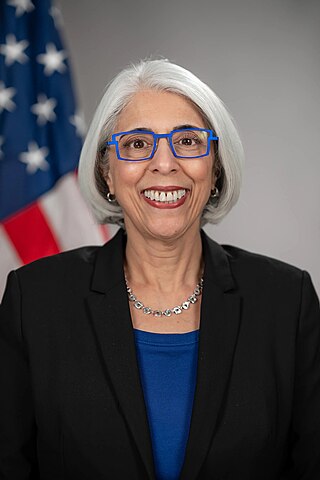
The Defense Advanced Research Projects Agency (DARPA) is a research and development agency of the United States Department of Defense responsible for the development of emerging technologies for use by the military.

An integrated circuit (IC), also known as a microchip, computer chip, or simply chip, is a small electronic device made up of multiple interconnected electronic components such as transistors, resistors, and capacitors. These components are etched onto a small piece of semiconductor material, usually silicon. Integrated circuits are used in a wide range of electronic devices, including computers, smartphones, and televisions, to perform various functions such as processing and storing information. They have greatly impacted the field of electronics by enabling device miniaturization and enhanced functionality.
The semiconductor industry is the aggregate of companies engaged in the design and fabrication of semiconductors and semiconductor devices, such as transistors and integrated circuits. It formed around 1960, once the fabrication of semiconductor devices became a viable business. The industry's annual semiconductor sales revenue has since grown to over $481 billion, as of 2018.
Anthony J. Tether served as Director of the Defense Advanced Research Projects Agency (DARPA) from June 18, 2001, until February 20, 2009. As Director, Dr. Tether was responsible for management of the Agency's projects for high-payoff, innovative research and development. In 2020, he became a consultant with MISTRAS Group, USA.

SEMATECH is a not-for-profit consortium that performs research and development to advance chip manufacturing. SEMATECH has broad engagement with various sectors of the R&D community, including chipmakers, equipment and material suppliers, universities, research institutes, and government partners. The group is funded by member dues.

Microelectronics and Computer Technology Corporation, originally the Microelectronics and Computer Consortium and widely seen by the acronym MCC, was the first, and at one time one of the largest, computer industry research and development consortia in the United States. MCC ceased operations in 2000 and was formally dissolved in 2004.
The International Technology Roadmap for Semiconductors (ITRS) is a set of documents that was coordinated and organized by Semiconductor Research Corporation and produced by a group of experts in the semiconductor industry. These experts were representative of the sponsoring organisations, including the Semiconductor Industry Associations of Taiwan, South Korea, the United States, Europe, Japan, and China.

Multi-project chip (MPC), and multi-project wafer (MPW) semiconductor manufacturing arrangements allow customers to share tooling and microelectronics wafer fabrication cost between several designs or projects.
The Semiconductor Industry Association (SIA) is a trade association and lobbying group founded in 1977 that represents the United States semiconductor industry. It is located in Washington, D.C.
A three-dimensional integrated circuit is a MOS integrated circuit (IC) manufactured by stacking as many as 16 or more ICs and interconnecting them vertically using, for instance, through-silicon vias (TSVs) or Cu-Cu connections, so that they behave as a single device to achieve performance improvements at reduced power and smaller footprint than conventional two dimensional processes. The 3D IC is one of several 3D integration schemes that exploit the z-direction to achieve electrical performance benefits in microelectronics and nanoelectronics.
The IEEE Robert N. Noyce Medal is a science award presented by the IEEE for outstanding contributions to the microelectronics industry. It is given to individuals who have demonstrated contributions in multiple areas including technology development, business development, industry leadership, development of technology policy, and standards development. The medal is named in honour of Robert N. Noyce, the co-founder of Intel Corporation. He was also renowned for his 1959 invention of the integrated circuit. The medal is funded by Intel Corporation and was first awarded in 2000.
The Western Institute of Nanoelectronics (WIN) is a research institute founded in 2006 and headquartered at the UCLA Henry Samueli School of Engineering and Applied Science in Los Angeles, California, US. The WIN Center networks multiple universities with the Industry and government based sponsors (members of the Semiconductor Industry Association consortium NRI) and the National Institute of Standards and Technology (NIST) in pursuit of replacing Complementary Metal-Oxide Semiconductor Field-Effect Transistors (CMOS FET). WIN's research is focused on spintronics extending from materials, devices, and device interactions, metrology and circuits/architectures. Sponsors include:
The United States government's Strategic Computing Initiative funded research into advanced computer hardware and artificial intelligence from 1983 to 1993. The initiative was designed to support various projects that were required to develop machine intelligence in a prescribed ten-year time frame, from chip design and manufacture, computer architecture to artificial intelligence software. The Department of Defense spent a total of $1 billion on the project.
Crosslight Software Inc. is an international company headquartered in greater Vancouver, British Columbia, Canada. Officially spun off from the National Research Council of Canada (NRC) in 1995, it provides Technology Computer Aided Design (TCAD) tools for semiconductor device and process simulations.

Tokyo Electron Limited, or TEL, is a Japanese electronics and semiconductor company headquartered in Akasaka, Minato-ku, Tokyo, Japan. The company was founded as Tokyo Electron Laboratories, Inc. in 1963. TEL is best known as a supplier of equipment to fabricate integrated circuits (IC), flat panel displays (FPD), and photovoltaic cells (PV). Tokyo Electron Device, or TED, is a subsidiary of TEL specializing in semiconductor devices, electronic components, and networking devices. As of 2011, TEL was the largest manufacturer of IC and FPD production equipment. Listed on the Nikkei 225, in 2024, Tokyo Electron had a market cap of US$114.6 billion, making it the third-most valuable company in Japan in terms of market cap, and the 12th ranked semiconductor-related company worldwide.

Arati Prabhakar is an American engineer and public official. Since October 3, 2022, she has served as the 12th director of the White House Office of Science and Technology Policy and Science Advisor to the President.
Dr. Márta Rencz is an Electrical Engineer. She is a faculty member and former Head of Department at the Budapest University of Technology and Economics and a member of the Hungarian Academy of Sciences.

Dr. Gary Patton is an American technologist and business executive. He is currently the Corporate Vice President and General Manager of Design Enablement and Components Research in the Technology Development Group at Intel. He has spent most of his career in IBM, starting in IBM's Research Division and holding management and executive positions in IBM's Microelectronics Division in Technology Development, Design Enablement, Manufacturing, and Business Line Management.
The Chinese semiconductor industry, including integrated circuit design and manufacturing, forms a major part of mainland China's information technology industry.

The CHIPS and Science Act is a U.S. federal statute enacted by the 117th United States Congress and signed into law by President Joe Biden on August 9, 2022. The act authorizes roughly $280 billion in new funding to boost domestic research and manufacturing of semiconductors in the United States, for which it appropriates $52.7 billion. The act includes $39 billion in subsidies for chip manufacturing on U.S. soil along with 25% investment tax credits for costs of manufacturing equipment, and $13 billion for semiconductor research and workforce training, with the dual aim of strengthening American supply chain resilience and countering China. It also invests $174 billion in the overall ecosystem of public sector research in science and technology, advancing human spaceflight, quantum computing, materials science, biotechnology, experimental physics, research security, social and ethical considerations, workforce development and diversity, equity, and inclusion efforts at NASA, the NSF, the DOE, the EDA, and NIST.









